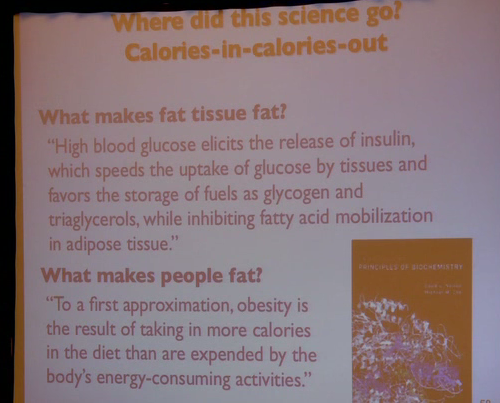{shhhhhhhhh .... don't tell Gary Taubes, this might just upset his 21DaySugarDetox approved green apple cart!}
You know how the story goes by now, right? In more recent lectures, Taubes is fond of using the slide below.

source
These are two quotes that Taubes cites from Lehninger's Principles of Biochemistry and he juxtaposes them to convince you how misguided such textbooks are. How can, on the one hand fat cells "fatten" according to the action of insulin, but human beings get fat due to positive energy balance? The simple answer is that insulin is not some renegade hormone and your pancreas is not a master organ in the body placating your rebellious adipocyte's every whim.
Yes, tis true that insulin has a stimulatory role in the storage of fatty acids by acting on LPL on the intake side, and yes, tis true that insulin "traps" those fatty acids in the adipocytes by suppressing HSL mediated lipolysis and release of same. Sounds like a slam dunk. If there's too much insulin, ostensibly from chronic spiking due to chronic carbohydrate consumption, the fat cells get stuck in storage mode and the horizontal growth disorder is primed for obesity!
Not so fast. How can the results of this study be then? Partial inhibition of adipose tissue lipolysis improves glucose metabolism and insulin sensitivity without alteration of fat mass. The abstract, bullet-pointed for ease of reading:
- When energy is needed, white adipose tissue (WAT) provides fatty acids (FAs) for use in peripheral tissues via stimulation of fat cell lipolysis.
- FAs have been postulated to play a critical role in the development of obesity-induced insulin resistance, a major risk factor for diabetes and cardiovascular disease. However, whether and how chronic inhibition of fat mobilization from WAT modulates insulin sensitivity remains elusive.
- Hormone-sensitive lipase (HSL) participates in the breakdown of WAT triacylglycerol into FAs. HSL haploinsufficiency and treatment with a HSL inhibitor resulted in improvement of insulin tolerance without impact on body weight, fat mass, and WAT inflammation in high-fat-diet–fed mice.
- In vivo palmitate turnover analysis revealed that blunted lipolytic capacity is associated with diminution in FA uptake and storage in peripheral tissues of obese HSL haploinsufficient mice.
- The reduction in FA turnover was accompanied by an improvement of glucose metabolism with a shift in respiratory quotient, increase of glucose uptake in WAT and skeletal muscle, and enhancement of de novo lipogenesis and insulin signalling in liver.
- In human adipocytes, HSL gene silencing led to improved insulin-stimulated glucose uptake, resulting in increased de novo lipogenesis and activation of cognate gene expression.
- In clinical studies, WAT lipolytic rate was positively and negatively correlated with indexes of insulin resistance and WAT de novo lipogenesis gene expression, respectively.
- In obese individuals, chronic inhibition of lipolysis resulted in induction of WAT de novo lipogenesis gene expression.
- Thus, reduction in WAT lipolysis reshapes FA fluxes without increase of fat mass and improves glucose metabolism through cell-autonomous induction of fat cell de novo lipogenesis, which contributes to improved insulin sensitivity.
Cliff Notes Version: Decreased lipolysis from WAT increased skeletal muscle glucose uptake and DNL in the liver without resulting in increased WAT mass. In the obese, suppressing WAT lipolysis induces DNL in the fat tissue. This improves glucose metabolism.
All of the evil things you were told insulin did to you -- turning carbs to fat in your liver and fat tissue and suppressing lipolysis from fat tissue -- are actually good for you. And the (temporary) trapping of fat in the adipose tissue improves insulin signaling and glucose handling in the skeletal muscle.
Imagine that ...
No comments:
Post a Comment